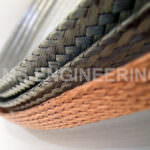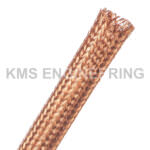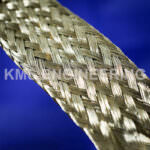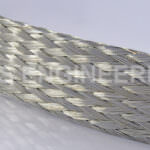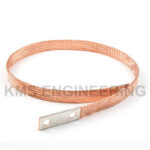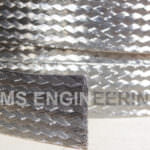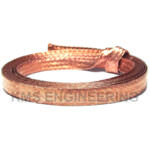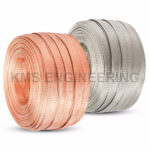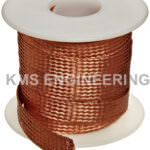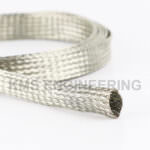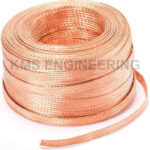- Copper braids are versatile and highly conductive electrical components used in a variety of applications, from grounding to EMI shielding. At their core, copper braids are made up of a network of intertwined copper wires, which are woven together to form a flexible, flat or tubular ribbon-like structure.
- One of the main advantages of copper braids is their ability to provide a low-resistance path for electrical current. This makes them ideal for use in grounding applications, where they help to prevent electrical shock and protect sensitive electronic components from damage. Copper braids are also commonly used in EMI/RFI shielding applications, where they provide a highly conductive shield against electromagnetic interference.
- The flexible copper braids can be used for flexible conduction and grounding connection of electrical installation, switch gear, electrical furnace, storage battery, etc. Both durable and flexible, it can be used to create a low resistance point-to-point ground strap.
- The braided copper consist of Cu-ETP wires which are braided together.
- Copper Braids are tinned to defer the oxidization process on copper when they are to be used in areas where the environmental conditions are harsh. These copper braids can be made in a wide range of finishes as well. All our copper braids are RoHS compliant.
- Copper Wire Braided Strip are provided with flexibility due to the lattice design of the wire. This helps them to withstand frequent pulling and bending.
- When selecting a copper braid, it is important to consider the specific application requirements, such as the desired level of conductivity, flexibility, and durability. Factors such as the size and shape of the braid, as well as the material and construction method used, can all impact its performance and suitability for a given application.
- There are several advantages of using copper braid in electrical applications:
- High Conductivity: Copper braid has excellent electrical conductivity, which allows it to provide a low-resistance path for electrical current. This is important in grounding and shielding applications, where low resistance is critical.
- Flexibility: Copper braid is highly flexible and can be easily bent, twisted, or shaped to fit into tight spaces or around complex shapes. This makes it ideal for use in applications where flexibility and ease of installation are important.
- Durability: Copper braid is highly durable and can withstand harsh environments and extreme temperatures without losing its conductivity or structural integrity. This makes it ideal for use in applications where reliability and longevity are important.
- Corrosion Resistance: Copper braid can be coated with a layer of tin or nickel to improve its corrosion resistance and conductivity. This makes it ideal for use in outdoor or marine environments where exposure to moisture and salt can cause corrosion.
- EMI/RFI Shielding: Copper braid provides excellent electromagnetic interference (EMI) and radio frequency interference (RFI) shielding, making it ideal for use in applications where signal interference needs to be minimized.
- Overall, copper braids are a reliable and versatile choice for a range of electrical applications, offering excellent conductivity, durability, and flexibility in a variety of sizes and configurations.
| Material: | Cu-ETP wires, C11000, copper content ≥ 99.95% |
| Finish: | Bare, tin plating, nickel plating, silver plating |
| C/S Area: | 0.2mm2 – 300mm2 |
| Wire Diameter: | 0.05mm(47swg) to 0.3mm(30swg) |
| Packing Modes: | in rolls, on spools or wooden drums |
- To help you choose the right conductor cross-section depending on the current rating, we have prepared a table with guideline figures.
- For more specific information please consult our highly qualified engineers who have many years of experience in the design of electrical equipment and are able to provide technical advice on your application.
| Nom. cross-section | Max. permitted current rating | Nom. cross-section | Max. permitted current rating | |
| mm2 | approx. A* | mm2 | approx. A* | |
| 0.10 | 5 | 25 | 150 | |
| 0.14 | 6 | 35 | 195 | |
| 0.20 | 7 | 50 | 250 | |
| 0.25 | 9 | 70 | 300 | |
| 0.35 | 10 | 95 | 360 | |
| 0.50 | 12.5 | 120 | 420 | |
| 0.75 | 15 | 150 | 480 | |
| 1 | 18 | 185 | 570 | |
| 1.50 | 21 | 240 | 670 | |
| 2.50 | 30 | 300 | 780 | |
| 4 | 40 | 400 | 950 | |
| 5.25 | 44 | 500 | 1100 | |
| 6 | 55 | 625 | 1300 | |
| 8 | 70 | 800 | 1500 | |
| 10 | 85 | 1000 | 1800 | |
| 16 | 120 |

